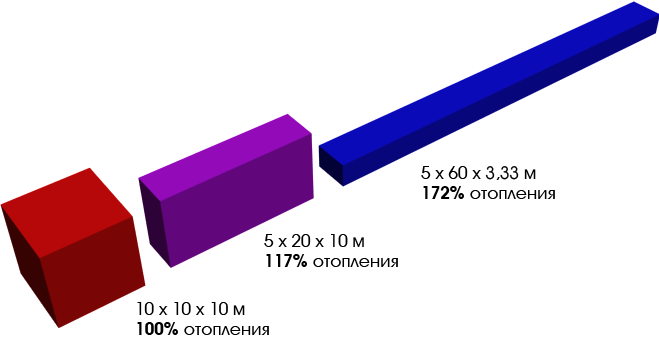3 Heat losses for heating the infiltrating outside air through the external doors and for heating the incoming transport
Estimated
air pressure difference ∆pi,
Pa, on the outer and inner surface
fencing is determined for each
rooms according to the formula:
∆pi=(H
– hi)*(γn
---γv)+0.5ν2*ρn*(WITHn
- WITHP)*Tov
–pint(3.4)
where
H -
height
buildings from ground level to the top of the eaves
or the mouth of the ventilation shaft, m;
hi
- estimated height from ground level to
top of windows, balcony doors, m;
γn,
γv
— specific gravity, N/m3,
respectively at outdoor temperature
(tnB
) and internal (tv)
air, determined by the formula:
(3.5)
v
— wind speed according to parameter B, m/s;
pn—
outside air density, kg/m3,
WITHn,
WITHP
are aerodynamic coefficients for
windward and leeward surfaces
fences equal to Cn=0,8,
WITHP=
— 0,6;
Tov—
coefficient of accounting for changes in speed
wind pressure depending on altitude
building;
pint
- conditionally constant air pressure,
Pa, indoor building (for residential
buildings).
Difference
pressure is determined by the formula:
∆p
= 0.55*H*(γn
–
γv)+0.03*γn*ν2,
(3.6)
Resistance
air permeability of windows and balconies
doors of residential buildings Rand
must be at least the required
air permeability Randtr,
m2 h/kg,
determined by the formula
(3.7)
where
—
normative breathability
external enclosing structures, for
external doors 7 kg/(m2 h).
Consumption
air infiltrated in the room
∑Gand,
kg/h, determined by the formula:
∑Gand
= 0,216,
(3.8)
where
∆pi
- the difference in air pressure at the outer
and the inner surface of the outer
fencing of the premises at the calculated
floor, Pa;
A
- area of windows and external doors, m2.
Consumption
heat for heating the infiltrating
air through guard Qand,
Tue:
Qand
= 0.28∑Gand
c(tv-tnB)
(3.9)
where
c is the specific heat capacity of air,
equal to 1 kJ/(kg ºС);
kn
is the coefficient for taking into account the influence of the counter
heat flow in the structure.
According to
, Indoor parking required
take into account the need for heat for heating
mobile vehicle entering the premises
composition Qauth,
W, in the amount of 0.029 W per hour per kg
curb weight per one
degree difference between the outside and
indoor air:
=
0.029 ∙ Mauth
∙ (tn
– tv),
(3.10)
where
Mauth
- mass of one car;
tv,
tn
- according to the temperature of the internal
and outside air, °С;
General
amount of heat loss for heating
incoming traffic Qauth,
W, will be:
Qauth
=
∙n,
(3.11)
where
n
- the number of cars in the parking lot.
Example
calculation heat loss
for heating the infiltrating external
air through external doors:
1.
Let's define the difference
pressure Δр:

=
14.49 N/m3,
=
11.98 N/m3;
2.
Calculate the air resistance:
3.
We define calculated differential pressure
air on outer and inner
fence surface:
4.
We calculate the flow rate of the infiltrating
air through the outer door:
ΣG
= 0,216·
= 21.89 kg/h;
5.
We calculate the heat consumption for
heating the infiltrated air
through the outer door:
Tue
results
calculations are summarized in Table 3.1.
table
3.1
Consumption
heat for heating the infiltrating
air through the outer doors of the staircase
cells
|
room number |
Name
tv, |
Square |
Regulatory
permeability |
Resistance |
Height |
Specific
air |
Specific |
Difference |
Estimated |
Estimated
pressure |
Consumption |
Heat loss
Qand, |
|
1 |
2 |
3 |
4 |
5 |
6 |
7 |
8 |
9 |
10 |
11 |
12 |
13 |
|
DD |
LK №1,
16 |
3,08 |
7 |
0,214 |
7,2 |
14,49 |
11,98 |
18,28 |
2,5 |
18,41 |
21,89 |
250 |
|
DD |
LK №2,
16 |
3,08 |
7 |
0,214 |
7,2 |
14,49 |
11,98 |
18,28 |
2,5 |
18,41 |
21,89 |
250 |
Example
calculation of heat losses for heating
incoming transport:
1.
Determine the heat loss per car:
=
0.029 ∙ 1300 ∙ (5 - (-34)) \u003d 1470.3 W.
2.
Find the total heat loss for
heating of incoming vehicles:
Qauth
\u003d 1470.3 ∙ 8 \u003d 11762.4 W.
Definition
total heat loss of the building is
in Q calculationR
for each room where it is installed
heater and summing them
everyone throughout the building.
QR=∑Q(1+∑ß)+
Qand.
(3.12)
Example
for room 103 director's office:
Across
outer wall:
Q
= 0.352 ∙ 8.28 ∙ (18-(-34) = 151.56 W,
Qext=
151.56 ∙ 1.05 = 159.13 W.
Across
window:
Q
= 2.046 ∙ 2.24 ∙ (18-(-34) = 238.32 W,
Qext=
238.32 ∙ 1.05 = 250.23 W
QR=159,56
+ 250.32 = 410 watts.
results
calculation of heat losses are summarized in the table
3.2.
Heat losses and their calculation on the example of a two-story building
Comparison of heating costs for buildings of different shapes.
So, let's take for example a small house with two floors, insulated in a circle. The coefficient of resistance to heat transfer near the walls (R) in this case will be on average equal to three. It takes into account the fact that thermal insulation made of foam or foam plastic, about 10 cm thick, is already attached to the main wall. At the floor, this indicator will be slightly less, 2.5, since there is no insulation under the finishing material. As for the roofing, here the resistance coefficient reaches 4.5-5 due to the fact that the attic is insulated with glass wool or mineral wool.
In addition to determining how capable certain interior elements are of resisting the natural process of volatilization and cooling of warm air, you will need to determine exactly how this happens. Several options are possible: evaporation, radiation or convection. In addition to them, there are other possibilities, but they do not apply to private living quarters. At the same time, when calculating heat losses in the house, it will not be necessary to take into account that from time to time the temperature inside the room may rise due to the fact that the sun's rays through the window heat the air by several degrees. It is not necessary in this process to focus on the fact that the house is in some special position in relation to the cardinal points.
In order to determine how serious heat losses are, it is enough to calculate these indicators in the most populated rooms. The most accurate calculation assumes the following. First you need to calculate the total area of all the walls in the room, then from this amount you need to subtract the area of \u200b\u200ball the windows located in this room and, taking into account the area of \u200b\u200bthe roof and floor, calculate heat loss. This can be done using the formula:
dQ=S*(t inside - t outside)/R
So, for example, if your wall area is 200 sq. meters, indoor temperature - 25ºС, and on the street - minus 20ºС, then the walls will lose approximately 3 kilowatts of heat for every hour. Similarly, the calculation of heat losses of all other components is carried out. After that, it remains only to sum them up and you will get that a room with 1 window will lose about 14 kilowatts of heat per hour. So, this event is carried out before the installation of the heating system according to a special formula.
The formula for calculating the heat loss of a private house
Total heat losses are calculated according to the formula from the main and additional heat losses (rounded up to 10 W).
The following quantities are used in the heat loss formula:
- K - heat transfer coefficient (table "K - heat transfer coefficient");
- F - wall area (in m2);
- R is heat transfer resistance (kcal/m2 x h x °C);
- tv and tp - temperature inside and outside the room;
- n - reduction factor, takes into account heat loss depending on the type of fences (table "n - reduction factor").
R values differ depending on the type of enclosing structures (table "Values R0 and 1/R0").
2 Additional heat loss
Main
heat loss through external fences,
due to temperature difference
indoor and outdoor air,
are less than the actual
heat loss, since the series is not taken into account
factors causing additional
heat losses, calculated in fractions of
basic heat losses or determined
calculation.
Qext=
QO∙Σβ,
(3.3)
where
Qext
— additional heat loss, W;
QO—
basic heat loss, W;
Σβ
- the sum of the coefficients of additional
heat loss:
—
on orientation to the cardinal points;
—
in the presence of two or more walls;
—
when cold air enters.
Additional
heat loss for side orientation
light is accepted in the amount of: 0.1 - for
walls, doors, windows facing north,
east, northeast, northwest;
0.05 - to the west and southeast; 0—
south and southwest.
Additional
heat loss through public fences,
administrative buildings at
the presence of two or more external walls in
one room is accepted in the amount of:
0.05 per wall, door, window if
one of the fences faces north,
east, northeast and northwest, and
0.1 otherwise.



